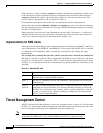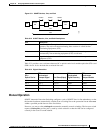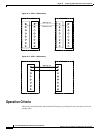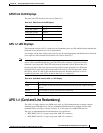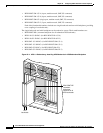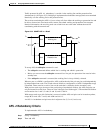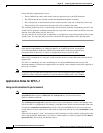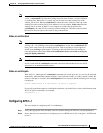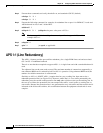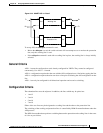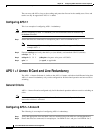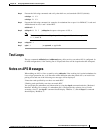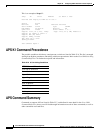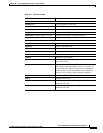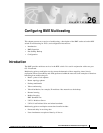
25-10
Cisco BPX 8600 Series Installation and Configuration
Release 9.3.10, Part Number 78-11603-01 Rev. D0, July 2001
Chapter 25 Configuring SONET Automatic Protection System
APS 1:1 (Line Redundancy)
Step 3 Execute these commands and verify chan half= no, and standard= GR-253 (default)
cnfcdaps 2.1 N 1
cnfcdaps 3.1 N 1
Step 4 Execute the following command, for example, for redundant line on port 1 for BXM OC-3 cards and
APS backcards in slots 2 and 3 of the BPX:
addcdred 23
Step 5 addapsln 2.1 3.1 1 {addapsln<slot.port> <slot.port> <1|2|3|..>
Note The last entry, “1”,intheaddapsln command specifies the type of APS, in this
example APS 1+1.
Step 6 cnfapsln 2.1
Step 7 upln 2.1 {or uptrk, as applicable
APS 1:1 (Line Redundancy)
The APS 1:1 feature provides port and line redundancy for a single BXM front card and associated
OC-3 or OC-12 redundant backcard.
There is no new hardware required to support APS 1:1. A single front card with a standard backcard is
used.
Two adjacent lines on the same card are used. The maximum number of connections supported by a
non-enhanced BXM card is reduced by half for APS 1:1 operation. Using enhanced BXM cards, the
number of available connections is not decreased.
Similarly to APS 1+1, SONET APS 1:1 requires that for every working line, there must exist a
redundant protection line (see Figure 25-6). However, unlike the 1+1 case, traffic protected by the
redundancy must be carried on the protection line only when a failure occurs on the working line. In
the case of no failure, the protection line can transport idle traffic, ‘same’ traffic as working line, or
extra traffic. Because the protection line is not guaranteed to carry real traffic until the transmit end is
informed of the failure and switches, this coordination between the equipment at both ends is more
complex.



